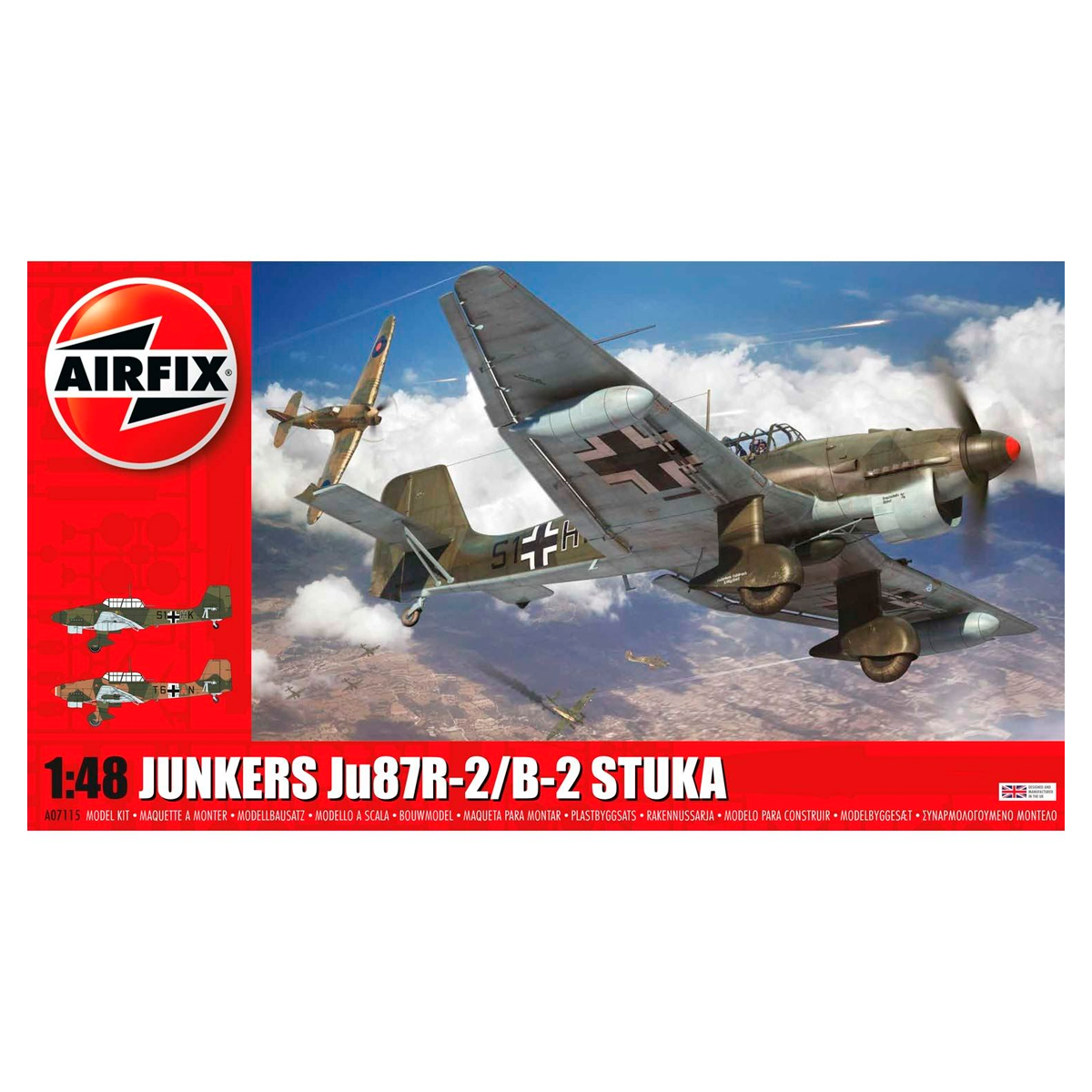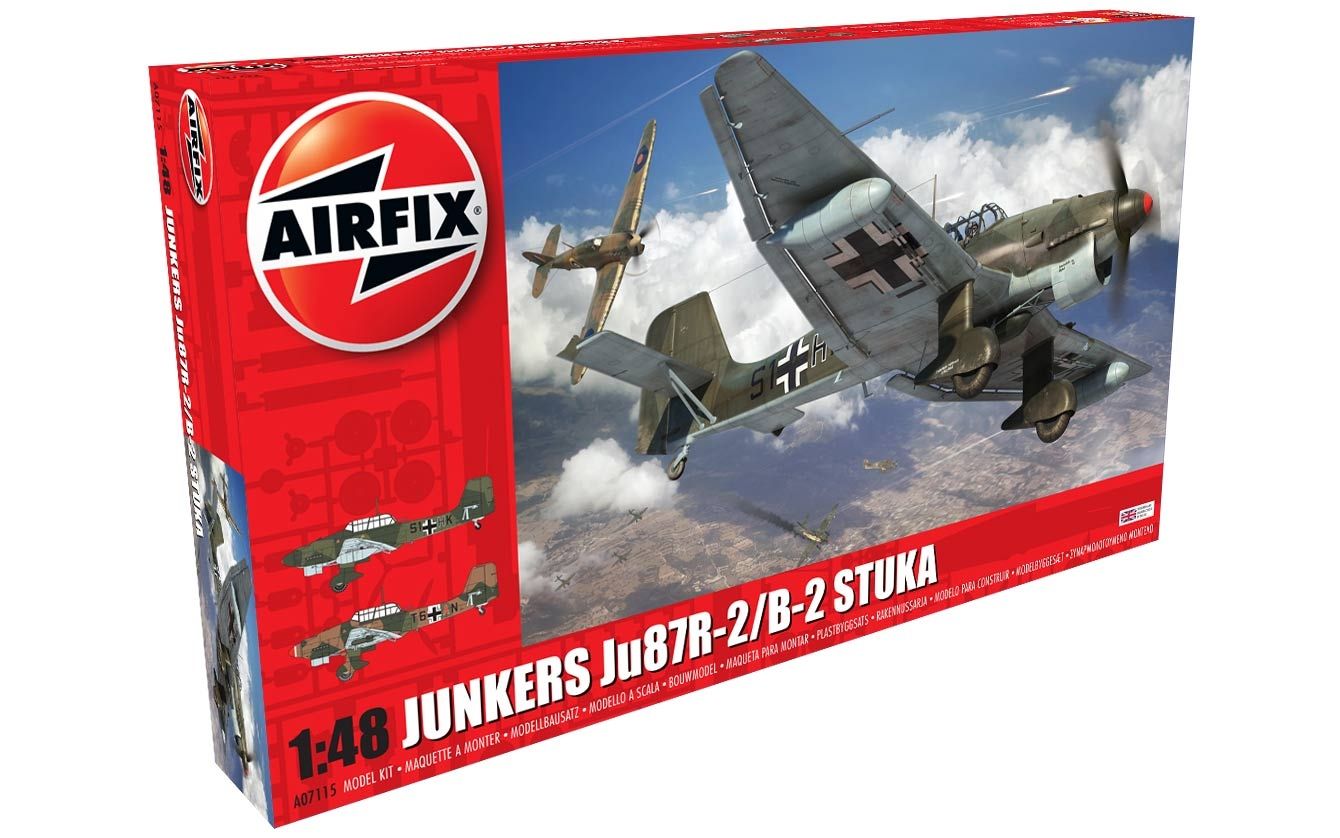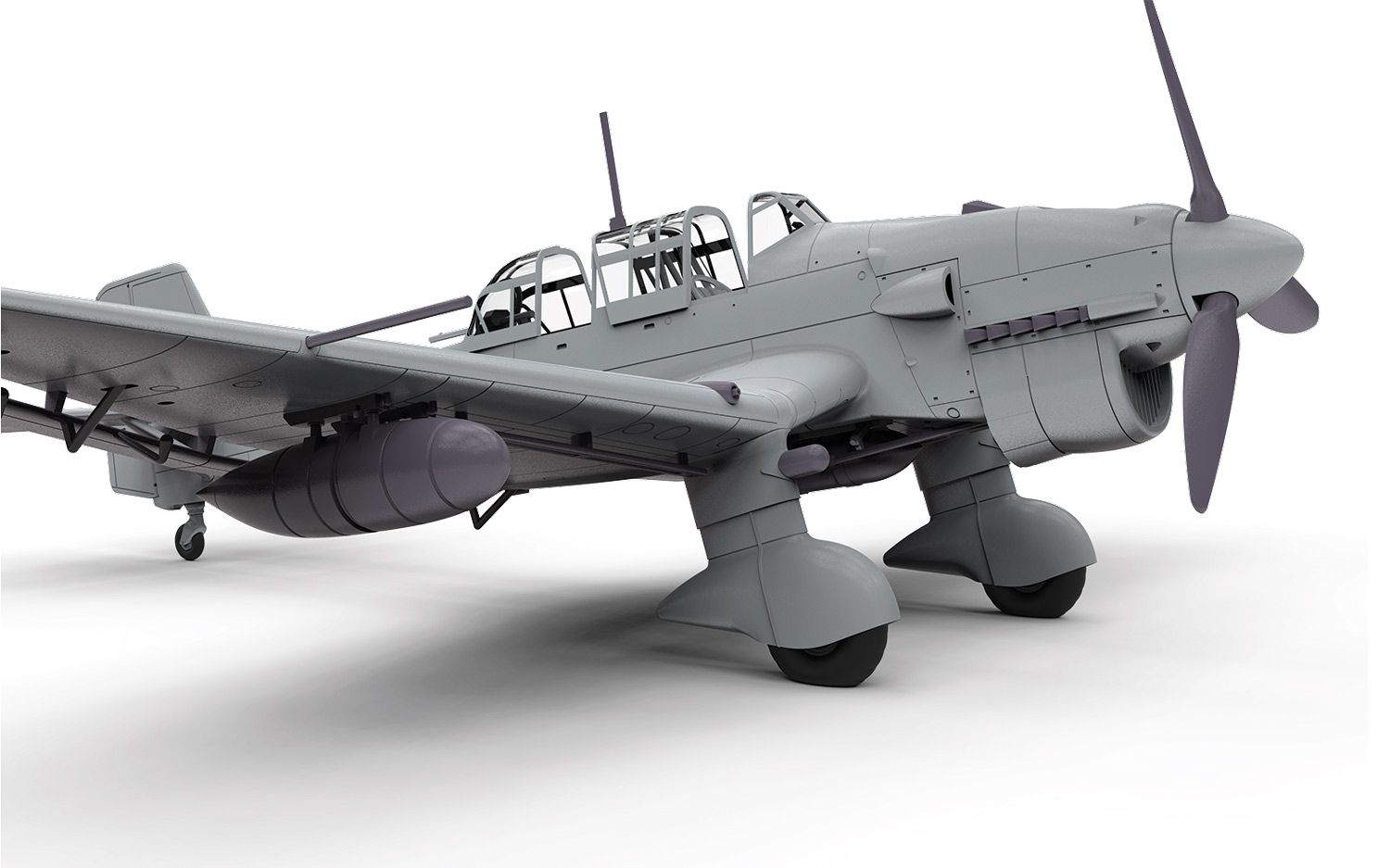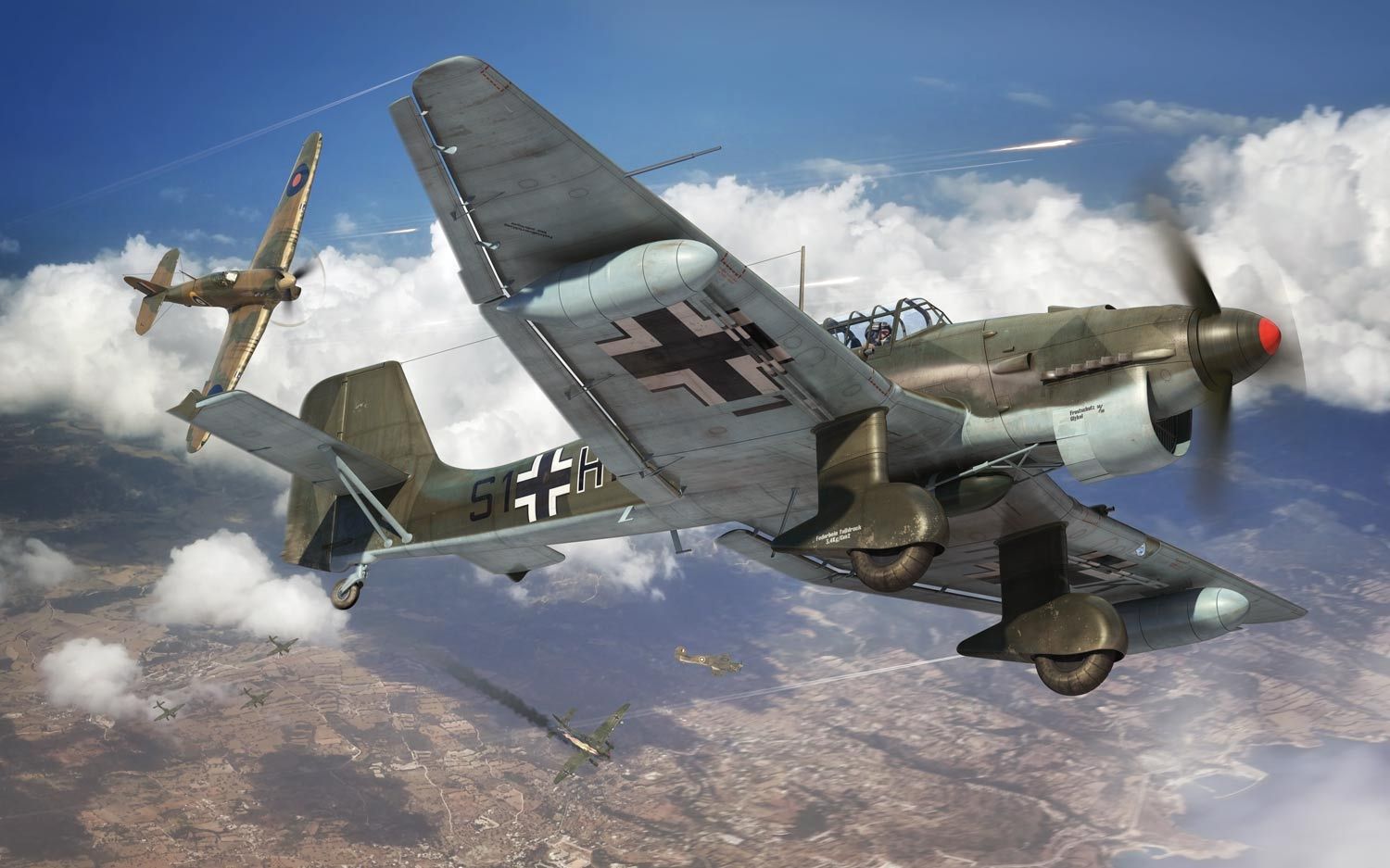Junkers JU87B-2/R-2 1/48
49,99€
Solo quedan 1 disponibles

*Please check our Privacy Policies to see how to we use your personal data.
*Por favor revisa nuestra Política de Privacidad para ver como tratamos tus datos personales
Although usually associated with the Wehrmachts feared Lightning War attacks at the beginning of WWII, the Ju87B Stuka was also a highly effective maritime strike bomber. Capable of performing precision dive bombing attacks against any Allied vessel, the Stuka took a heavy toll of shipping in the English Channel, North Africa and in the Mediterranean. The Stuka also saw service with the air forces of Italy, Romania, Bulgaria and Hungary, as well as remaining in Luftwaffe service throughout WWII. The attack dive of the Stuka was so severe, that quite a number of automatic features had to be incorporated into the manoeuvre.
At an altitude of approximately 15,000 ft., the pilot would locate his target through a bombsight window, which was located in the floor of the cockpit. His engine and propeller had automatic controls, to optimise the aircraft when in a dive, and an automatic trimmer would make the aircraft tail heavy, as the pilot initiated the dive. He would move the dive lever to the rear, which would limit the kick of the control column and quickly begin a defined sequence of actions, which if done correctly, would see his ordnance detonate on his intended target. He quickly set the trim tabs, reduced the throttle and closed the engine coolant flaps. The aircraft would automatically become tail heavy and pitch over in a 180-degree roll, placing the aircraft in a steep nose-down dive at the same time, dive breaks were automatically deployed, to reduce the speed of the dive, to a constant 360 mph. This was the point of no return as the attack sequence had begun.
As the strain on the body of the pilot increased, he still had much work to do. The angle of his dive could be checked by looking at a series of red lines on the side of his cockpit window and lining them up against the horizon 60, 75, or 80 degree angle of attack. He would then look forward through the fixed gun sight, to line up his attack, before releasing his heavy main bomb – the optimum release height was indicated to the pilot, by a light flicking on in his altimeter. The bomb was carried on a large U-shaped cradle, which would swing down on release, throwing the bomb safely clear of the large propeller and on to the target. As all this action was taking place, the pilot would have certainly had at least a couple of reassuring glances at the red pins protruding up from the top of the wings, which informed him that the automatic dive recovery system was engaged, should he fall victim to a g-induced black-out. All this would have been taking place in just a matter of a few, frantic seconds!
Once the bombs had left the aircraft, it automatically began its dive recovery sequence. This was the point at which the maximum g loading on the crew would be felt and forces in excess of six times the force of gravity were regularly experienced, which could result in vision impairment at the very least. Once recovered and the nose of the aircraft was above the horizon, the dive breaks were automatically retracted, the throttle was opened and the propeller was set to climb the pilot then quickly had to manually open the coolant flaps, to prevent the engine from overheating and then resume flying the aircraft.
This was the point that the Stuka was at its most vulnerable, flying at low level, at relatively slow speed and in hostile territory. His rear gunner may still be blacked out and indeed the pilot might still be feeling a little light headed, but every anti-aircraft gun, rifle and enemy fighter in the vicinity would be taking pot-shots at them, from every angle.
Tech Specs
Item Length – Without Packaging (cm) 22.9
Item Height – Without Packaging (cm) 8.35
Item Width – Without Packaging (cm) 28.8
How many pieces will be found in the box opened by the customer? 158
Item Scale 1:48
Contents: Sprues & decals
Number of Scheme options 2
Skill Level 3
Flying Hours 3
Wingspan (mm) 288
Aunque normalmente se asocia con los temidos ataques relámpago de la Wehrmacht a principios de la Segunda Guerra Mundial, el Ju87B Stuka también fue un bombardero de ataque marítimo muy eficaz. Capaz de realizar ataques de bombardeo en picado de precisión contra cualquier buque aliado, el Stuka se cobró un elevado número de víctimas en el Canal de la Mancha, el norte de África y el Mediterráneo. El Stuka también estuvo en servicio en las fuerzas aéreas de Italia, Rumanía, Bulgaria y Hungría, y en la Luftwaffe durante toda la Segunda Guerra Mundial. El ataque en picado del Stuka era tan severo que hubo que incorporar a la maniobra un buen número de automatismos.
A una altitud aproximada de 15.000 pies, el piloto localizaba su objetivo a través de una mirilla situada en el suelo de la cabina. El motor y la hélice tenían controles automáticos para optimizar la aeronave en picado, y un trimmer automático hacía que la aeronave pesara en la cola cuando el piloto iniciaba el picado. Movía la palanca de inmersión hacia atrás, lo que limitaba la patada de la columna de control e iniciaba rápidamente una secuencia definida de acciones que, si se realizaban correctamente, harían detonar su artillería sobre el objetivo previsto. Rápidamente ajustó las aletas de centrado, redujo el acelerador y cerró los flaps de refrigeración del motor. Automáticamente, el avión se puso de cola y se inclinó 180 grados, cayendo en picado al mismo tiempo que se desplegaban automáticamente los frenos de picado para reducir la velocidad a 360 mph. Este fue el punto de no retorno, ya que la secuencia de ataque había comenzado.
A medida que aumentaba la tensión en el cuerpo del piloto, aún le quedaba mucho trabajo por hacer. El ángulo de su picado podía comprobarse mirando una serie de líneas rojas en el lateral de la ventanilla de su cabina y alineándolas con el horizonte 60, 75 u 80 grados de ángulo de ataque. Entonces miraba hacia delante a través de la mira fija del cañón, para alinear su ataque, antes de soltar su pesada bomba principal – la altura óptima de lanzamiento se indicaba al piloto, mediante una luz que se encendía en su altímetro. La bomba se transportaba en una gran cuna en forma de U, que se balanceaba hacia abajo al soltarla, lanzándola con seguridad lejos de la gran hélice y hacia el objetivo. Mientras se llevaba a cabo toda esta acción, el piloto habría echado al menos un par de miradas tranquilizadoras a los pasadores rojos que sobresalían de la parte superior de las alas, que le informaban de que el sistema automático de recuperación en picado estaba activado, en caso de que fuera víctima de un desmayo inducido por la gravedad. Todo esto habría tenido lugar en cuestión de unos pocos y frenéticos segundos.
Una vez que las bombas habían abandonado el avión, éste iniciaba automáticamente su secuencia de recuperación en picado. Este era el momento en el que la tripulación sufría la máxima carga de gravedad y se experimentaban fuerzas superiores a seis veces la fuerza de la gravedad, lo que podía provocar, como mínimo, problemas de visión. Una vez recuperado y con el morro del avión por encima del horizonte, los frenos de inmersión se retraían automáticamente, se abría el acelerador y la hélice se ponía en ascenso. El piloto tenía entonces que abrir manualmente los flaps de refrigeración para evitar el sobrecalentamiento del motor y reanudar el vuelo.
Este era el momento en que el Stuka era más vulnerable, volando a bajo nivel, a velocidad relativamente lenta y en territorio hostil. Su artillero de retaguardia podía seguir desmayado y, de hecho, el piloto podía seguir sintiéndose un poco mareado, pero todos los cañones antiaéreos, fusiles y cazas enemigos de los alrededores estarían disparándoles desde todos los ángulos.
Especificaciones técnicas
Longitud del artículo – Sin embalaje (cm) 22.9
Altura del artículo – Sin embalaje (cm) 8.35
Anchura del artículo – Sin embalaje (cm) 28.8
¿Cuántas piezas se encontrarán en la caja abierta por el cliente? 158
Escala del artículo 1:48
Contenido: Matrices y calcas
Número de esquemas 2
Nivel de habilidad 3
Horas de vuelo 3
Envergadura (mm) 288










 Solicitud de ficha producto tipo SDS / Seguridad de producto
Solicitud de ficha producto tipo SDS / Seguridad de producto